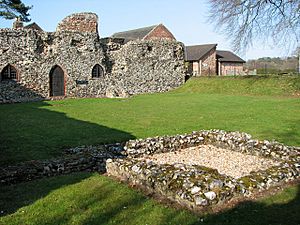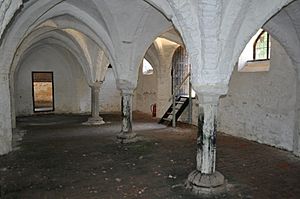St Olaves Priory, Herringfleet facts for kids
Herringfleet Priory, also known as St Olave's Priory, was once a home for a group of monks called Augustinian Canons. These were like monks who followed the rules of Saint Augustine. The priory was located in a place called St Olaves, about 6 miles northwest of Lowestoft in eastern England. Even though it's now in Norfolk, it used to be part of Suffolk before 1974.
The priory was started in 1239. It was built near an old ferry crossing on the River Waveney. Sir Roger Fitz Osbert of Somerley founded this priory during the time of King Henry III. Today, you can still see parts of the old priory, like the undercroft (a basement room), two aisles of the Lady Chapel (a special part of the church), and the refectory (the dining hall), which is now used as a barn.
Discovering Herringfleet Priory
The priory was originally dedicated to "St Olave, The Blessed Virgin Mary, and St Edmund, King and Martyr." Saint Olaf was a king of Norway who lived around 995 AD and helped bring Christianity to his country. While there was only one place dedicated to Saint Olaf in Suffolk, there were two in Norfolk and over fifty across the rest of England.
The Priory's End
In 1536, a big change happened across England called the Dissolution of the Monasteries. This was when King Henry VIII closed down many monasteries and priories. Sir Humphrey Wingfield, a royal official, arrived at Herringfleet Priory on August 20, 1536. A few years later, on January 16, 1546, King Henry VIII gave the priory's land to a local man named Sir Henry Jerningham of Somerleyton.
Today, the priory is in ruins, but its name lives on. St. Olave's Bridge, which crosses the River Waveney, replaced the old ferry near the priory. There's also a modern railway junction named after St. Olave's.
Life at the Priory
The monks at Herringfleet Priory had special rights. They were allowed to hold an annual fair on St Olave's Day, which is July 29. They also had control over the areas of Herringfleet and Burgh St Peter.
Archaeologists have explored the area around the priory. They have found several burials in the canons' cemetery, showing where some of the monks were laid to rest. The ruins of Herringfleet Priory are now looked after by English Heritage, an organization that protects historical sites.
Priors of Herringfleet
A Prior was the head of a priory, similar to an abbot in a larger monastery. They were in charge of the monks and the daily running of the priory. Here are some of the people who served as Prior at Herringfleet:
- 1273 William
- 1300 Bennedict
- 1303 Thomas of Norwich
- 1309 William Dale
- 1329 John de Tybenham
- 1341 Philip of Herlingland
- 1354 John of Surlingham
- 1370 Roger of Haddiscoe
- 1391 John of Hanewell
- 1401 John of Wylughy
- 1430 John Wells
- 1460 William Bugal
- 1468 William Beverley
- 1480 Thomas Baget
- 1541 William Dale



